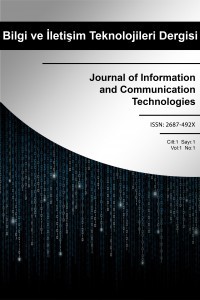MIT App Inventor ve Android Studio Kullanılarak Tasarlanmış Mobil Uygulamanın Performans Karşılaştırması
MIT App Inventor, Android Studio, Performans Ölçütleri, Eğitsel Mobil Uygulama
Comparison of Performance of Mobile Application Developed in MIT App Inventor and Android Studio
___
- Akyol, G. (2014). Mobil uygulama arayüzlerinin incelenmesi üzerine bir çalışma. ISITES2014, Karabük.
- Biørn-Hansen, A., Grønli, T.M., & Ghinea, G. (2019). Animations in cross-platform mobile applications: An evaluation of tools, metrics and performance. Sensors, 19(9), 1-21.
- Castro, P. H. P., Barreto V. L., Corrêa, S. L., Granville, L. Z. & Cardoso, K. V. (2015). A joint CPU-RAM energy efficient and SLA-compliant approach for cloud data centers. Computer Networks, 94, 1286-1389.
- Eldem, H. (2016). Yazılım geliştirme eğitimine yeni bir bakış blok programlama teknolojisi. Honor Committee, 211.
- Google Developers. (2020, Nisan). Developer workflow basics studio. https://developer.android.com/studio/workflow adresinden elde edildi.
- Google Developers. (2020, Nisan). Meet android studio. https://developer.android.com/studio/intro adresinden elde edildi.
- Google Developers. (2020, Nisan). Run apps on the Android Emulator. https://developer.android.com/studio/run/emulator adresinden elde edildi.
- Google Developers. (2020, Mayıs). Profile your app performance. https://developer.android.com/studio/profile adresinden elde edildi.
- Halpern, M., Zhu Y. & Reddi, V. J. (2016). Mobile CPU's rise to power: Quantifying the impact of generational mobile CPU design trends on performance, energy, and user satisfaction. 2016 IEEE International Symposium on High Performance Computer Architecture (HPCA), 64-76.
- Kayande, D. & Shrawankar, U. (2012). Performance analysis for improved RAM utilization for Android applications. 2012 CSI Sixth International Conference on Software Engineering (CONSEG), 1-6.
- Kundu, T. P. & Paul, K. (2010). Android on mobile devices: An energy perspective. 10th IEEE International Conference on Computer and Information Technology (CIT 2010), 2421-2426.
- Massachusetts Institute of Technology. (2020, Nisan). About app inventor. https://app Inventor.mit.edu/about-us adresinden elde edildi.
- Massachusetts Institute of Technology. (2020, Nisan). Designer and blocks editor. https://app Inventor.mit.edu/explore/designer-blocks adresinden elde edildi.
- Rumi, M. A., Asaduzzaman & Hasan, D. M. H. (2015). CPU power consumption reduction in android smartphone. 2015 3rd International Conference on Green Energy and Technology (ICGET), 1-6.
- Ryan, C. & Rossi, P. (2005). Software, performance and resource utilisation metrics for context-aware mobile applications. 11th IEEE International Software MetricsSymposium (METRICS'05), 10-12.
- Statista. (2020, Nisan). Number of appsavailable in leadingappstores as of 4th quarter 2019. https://www.statista.com/statistics/276623/number-of-apps-available-in-leading-app-stores adresinden elde edildi.
- Tunalı, V., & Zafer, S. (2015). Comparison of popular cross-platform mobile application development tools. Ulusal Yönetim Bilişim Sistemleri Kongresi (YBS2015), 1357–1365.
- Oracle. (2020, Nisan). Java teknolojisi hakkında bilgi edinin. https://www.java.com/tr/about adresinden elde edildi.
- WeAreSocial. (2020, Nisan). Global digital report 2019. https://wearesocial.com/blog/2019/01/digital-2019-global-internet-use-accelerates adresinden elde edildi.
- Wolber, D., Abelson, H., & Friedman, M. (2015). Democratizing computing with app inventor. Mobile Computing and Communications, 18(4), 53-58.
- ISSN: 2687-492X
- Yayın Aralığı: Yılda 2 Sayı
- Başlangıç: 2019
- Yayıncı: Ramazan Yılmaz
PISA 2018 Araştırmasına Etki Eden Duygusal Faktörlerin Veri Madenciliği Yöntemleri İle İncelenmesi
Zeynep SAĞLAM, Mehmet Fatih PEKYÜREK, Ramazan YILMAZ
Mehmet Fatih PEKYÜREK, Zeynep SAĞLAM, Ahmet Berk USTUN
Eren ÖZEREN, Tahsin ÇİLOĞLU, Ramazan YILMAZ, Ahmet ÖZEREN
Türkiye'de Hibrit Öğrenme Uygulamaları ve Etkileri: Bir Meta Analiz Çalışması
